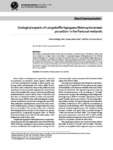Please use this identifier to cite or link to this item:
http://www.alice.cnptia.embrapa.br/alice/handle/doc/1031763| Title: | Ecological aspects of Langsdorffia hypogaea (Balanophoraceae) parasitism in the Pantanal wetlands. |
| Authors: | LEHN, C. R.  SALIS, S. M. de   MATTOS, P. P. de   |
| Affiliation: | CARLOS RODRIGO LEHN, INSTITUTO FEDERAL FARROUPILHA; SUZANA MARIA DE SALIS, CPAP; PATRICIA POVOA DE MATTOS, CNPF. |
| Date Issued: | 2015 |
| Citation: | Acta Botanica Brasilica, v. 29, n. 4, p. 608-612, 2015. |
| Description: | Most studies on holoparasitic plants have focused on taxonomic or systematic issues. The objective of this study was to examine the ecological aspects of parasitism of Langsdorffia hypogaea (Balanophoraceae) in the Pantanal wetlands. Individuals of L. hypogaea were dug out by hand and the host trees were identified. Eighty-eight percent of host trees exhibited zoochory dispersal syndrome. Protium heptaphyllum and Cordiera sessilis represented 50% of the sampled trees. Both species are evergreen and are preferentially shade-tolerant species growing under the canopy of other trees. Fecal sample of collared peccaries (Pecari tajacu) had seeds from both the host tree (Protium sp.) and the parasite L. hypogaea. We therefore propose the hypothesis that P. tajacu play a role as a seed disperser and may affect root parasitism. |
| Thesagro: | Parasito Cerrado Raiz Hospedeiro vegetal |
| NAL Thesaurus: | Host plants Parasites Pantanal host specificity |
| Keywords: | Parasite Root Savanna |
| DOI: | 10.1590/0102-33062015abb0216 |
| Type of Material: | Artigo de periódico |
| Access: | openAccess |
| Appears in Collections: | Artigo em periódico indexado (CPAP)  |
Files in This Item:
| File | Description | Size | Format | |
|---|---|---|---|---|
| 01023306abb290400608.pdf | 1,76 MB | Adobe PDF |  View/Open |









